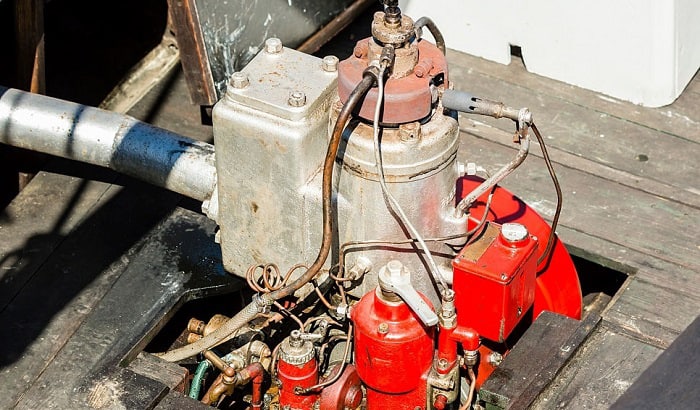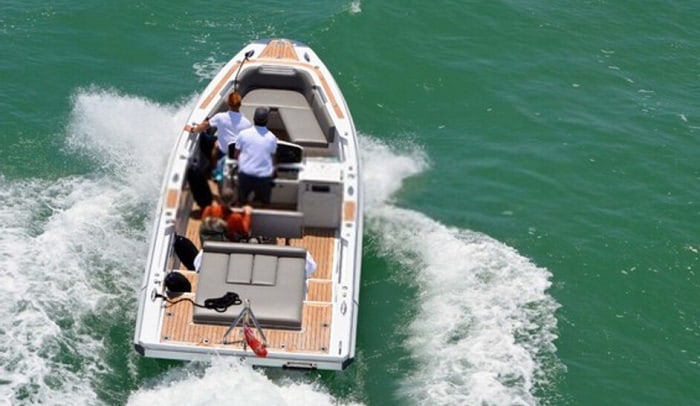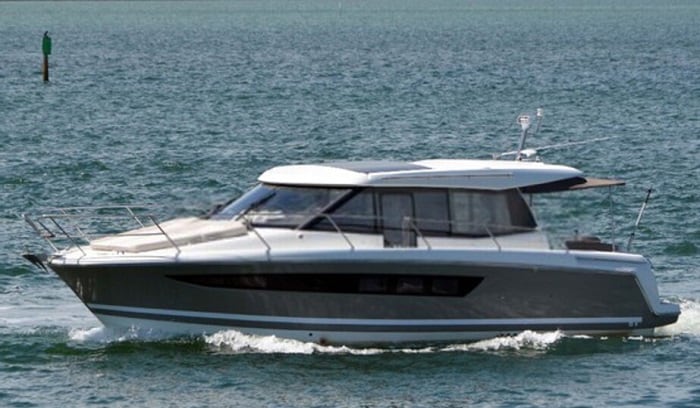Testing a boat engine is crucial before launching it into the water. It shows any problem, especially after winterization. Doing it right is necessary for the safety and prevention of irreversible damage.
You can use either a circular plunger or a motor flusher for starting an inboard engine on land. These tools will create a strong suction in a cup where water pools; so that the motor will not run dry.
Curious about how to start an inboard boat engine out of water? I will share the steps in this guide.
Table of Contents
What You Will Need
For this simple tutorial, you will need a garden hose and one of the two pieces of equipment that will supply water to the engine as it runs.
Circular Plunger
This tool looks like a standard toilet plunger. Also known as fake-a-lake, it does what’s in its name. Water accumulates on the cup to mimic the conditions of a lake, allowing the inboard engine to start safely.
It comes with an outlet that connects to a garden hose. Once in position, it covers the boat’s water intake. After turning on the faucet, water pools in the plunger before the motor turns on.
An alternative option for this tool is the SeaSense Inboard Motor Flusher. It is adjustable from 15.5 to 30 inches, allowing it to support your boat on the ground.
Motor Flusher
It looks like ear muffs, with the primary function of keeping the water supply in its cups. The flusher connects to the motor’s inlet vents, which will suck water. It will prevent the engine from running dry when it is out of the water.
The flusher also gets rid of dirt and debris on the motor, which should be part of regular maintenance. It is particularly critical after winterization or long-term storage. It gets rid of salt, silt, and sand, among others.
SeaChoice 18301 ProFlo Universal Flusher is an excellent example of a product you can use when testing an engine. It has rubber cups flexible enough to fit a wide array of inboard motors.
Step-By-Step Guide
Boating season is exciting, but do not bring your vessel immediately into the water without testing the engine. While it is in a dry area, below are the steps to starting the inboard engine.
Starting an Inboard Engine with a Circular Plunger
To make things easier, I suggest you watch this video to see how you can use fake-a-lake or a circular plunger.
- Connect a hose under the open part of the plunger. Thread tightly for a secure fit. Otherwise, it will disconnect when the water pressure gets too high.
- Turn on the faucet. This will let you test the flow. Turn off the water supply.
- Go under the boat and look for the water intake. It is the hole where the engine sucks the water.
- Position the plunger on the water intake. Adjust the leg depending on the distance between the boat and the ground. Wobble slightly, seeing to it that the handle does not move.
- Once the plunger is in a secure position, turn on the water supply at the maximum. Water will start overflowing on the plunger’s cup.
- Turn on the inboard engine. As the motor runs, the pressure of the water getting out of the plunger slightly decreases. It is a good sign that the engine is working as it should.
- Turn off the engine and the faucet. Remove the plunger from the water intake.
Starting an Inboard Engine with a Motor Flusher
This video shows the basics of using a motor flusher. For a more detailed guide on how to do this, here are the things to do.
- Pour water on the motor flusher. This is important to create a tighter seal, which will prevent accidentally sliding when water runs.
- Look for the water intake and attach the flusher. As you slide into the lower part of the motor, see to it that you fully cover the hole for more powerful suction.
- With the muffs in position, connect the garden hose. Secure it snugly into the nozzle.
- Connect the other end of the garden hose to the faucet and turn on the water supply.
- Proceed to the engine of the boat and turn to neutral. Switch the engine on to run it.
- With the engine running, the water flowing out will have lower pressure.
- Once you are done testing the engine, turn it off.
Pro Tips
Below are some helpful tips when starting an inboard engine of your boat even if it is out of water:
- Find a flat and open area where you will park your boat. Mount it on a trailer high enough so that you can access the water intake.
- Fit the plunger tightly on the vent. Otherwise, the high pressure from the water will cause it to slide and the engine will be running dry.
- Power off the boat engine before the water when you are finished. It will supply enough liquid to the cup to prevent damage.
- Run the engine for five to ten minutes. This is long enough to make sure that it is properly working while also flushing debris that could have been stuck during the boat’s storage.
Conclusion
Starting an inboard engine out of the water is necessary to manage its peak performance after storage. This way, you can spot any problem and make immediate repairs before running the motor.
To prevent the engine from running dry and to test its functions, you can use SeaSense Inboard Motor Flusher or SeaChoice 18301 ProFlo Universal Motor Flusher.
Did you learn anything from this guide on how to start an inboard boat engine out of water? Are there other things you would like to add? Do not hesitate to write a comment below!

I am passionate about water sports and technical fields, so combining both makes me interested in making contents about boat accessories. With my partner, we went on many trips and sports games together, which led us to think about how we can spread our joys and passions to many people.



